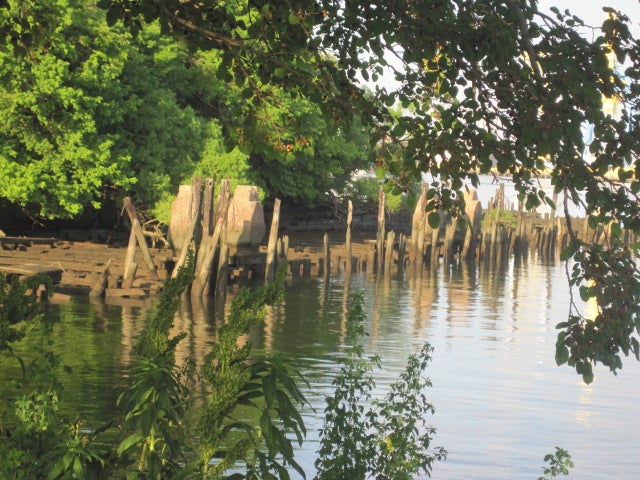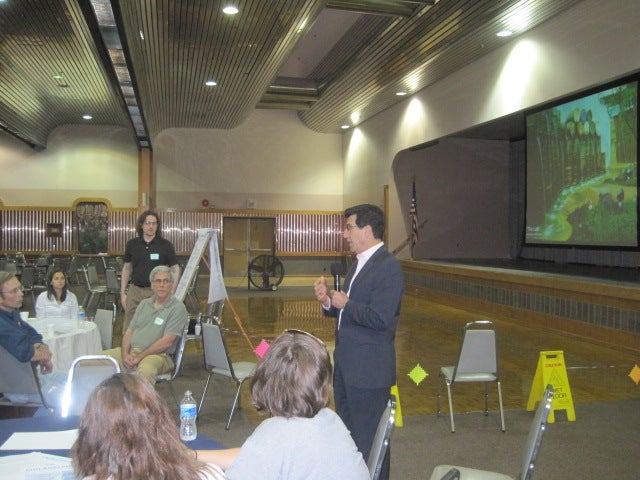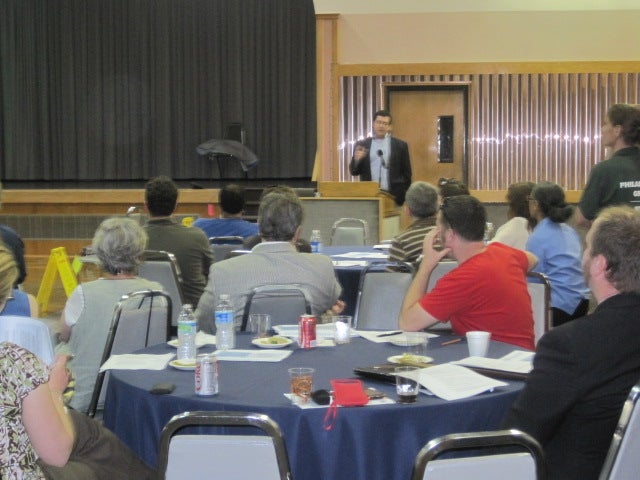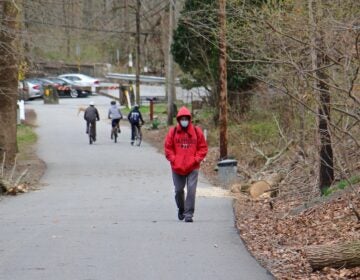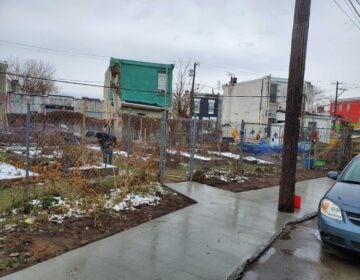Going green, one acre at a time
May 26, 2010
By JoAnn Greco
For PlanPhilly
Standing in the blazing sun, about thirty curious souls joined Amanda Benner of the Pennsylvania Horticultural Society for a sneak preview of what will soon be Philadelphia’s first “pop-up” park. For now, a weed-strewn one-acre lot fronting the Delaware River in between two rotting piers, the site serves as an example of a “new open space that’s actually happening,” Benner told her audience.
The brief jaunt kicked off a series of six community meetings intended to familiarize neighbors with Green2015, a program to add 500 acres of open space to Philadelphia in the next five years, and part of the larger citywide green initiative Greenworks. Each meeting will be held at an extant or promised green space around town, said Benner.
The pop-up park, behind the Sheet Metal Workers Union building on Columbus Blvd. and Washington Ave., basically involves cleaning up brush, removing hardscaping, and leaving the deteriorating pier in its naturalized state (with perhaps a boardwalk extending down its center). It will be up-and-running for bikers, birdwatchers, and those who saunter within the next few months.
When it’s done, several laughed, we’ll be down to 499 acres of new space to create.
People seemed surprised and excited about the speed of the project, and had a few questions about access, security, and where the thing had come from in the first place. Benner spoke of signs and locks and lighting, but demurred on the details, saying that they would be under the auspices of the Delaware River Waterfront Corporation. Joan Reilly, also of PHS, explained that the pop-up park was an early-action project of the Central Delaware master plan.
Back inside, the meeting got underway with brief introductions on the plan by Parks & Rec Commissioner Michael DiBerardinis, and an overview by Harris Steinberg, director of PennPraxis, of how other cities around the world have introduced new parkland into their mix.
It all served as inspiration for the meat of the gathering, a facilitated roundtable format designed to elicit from participants some governing principles that should influence how the 500 acres are parceled out.
Previous work of this nature has determined the priorities of the plan — from bike and pedestrian access to more trees to improved waterfronts — said Harris Sokoloff, director of the Penn Project for Civic Engagement. Now, he said, we need to come to an understanding of the criteria for accomplishing those goals.
Participants were encouraged to first discuss meaningful experiences they’ve had in natural settings and to expand on that by sharing what role their favorite green spaces in Philadelphia play in their lives and their communities. The next discussion point — what role might these spaces play? (neighborhood connectors, teaching opportunities, a source of pride) — led to a solidification of the program’s guiding principles.
From answers along the lines of “develop a sense of place,” “create a legacy,” “honor the past,” “celebrate the present,” and “protect nature,” Sokoloff noticed an “interesting web of connections” that skewed toward creating a sense of ownership and valuing natural settings for the many benefits they provide.
The group was enthusiastic and willing to go along for the ride, although several audience members revealed that the meeting wasn’t quite what they expected. Someone questioned whether this was a little too-much-talk, too-little-action, while a few griped that they had hoped to learn about getting grant money to fund their specific park projects.
Most, however, seemed pleased with the exercise. “This was great,” said Vincent Ricchiuti of Girard Park. “We’ll be able to leverage some of these ideas for our own park, and we came away with some great contacts.”
Judith Robinson of the newly-formed group Susquehanna Clean Up, Pick Up was excited. “These ideas were very helpful, particularly about getting community buy-in,” she said. Her organization is seeking to convert a 14,000-square-foot lot (hmmm….that’s about a third of an acre) near Temple into a rain garden. Brandishing a letter noting that it had just received a $3,000 grant from the PA Department of Environmental Protection, she exclaimed: “We made a grassroots decision to take matters into our own hands. It’s time to take control and be creative, and it’s exciting to see so many folks from other neighborhoods willing to do the same thing.”
Who knows, by the time all of the other roundtables are completed, maybe there will only be 498 acres of open space left to create.
Contact JoAnn Greco at www.joanngreco.com
Check out her new online magazine, TheCityTraveler at www.thecitytraveler.com
WHYY is your source for fact-based, in-depth journalism and information. As a nonprofit organization, we rely on financial support from readers like you. Please give today.



